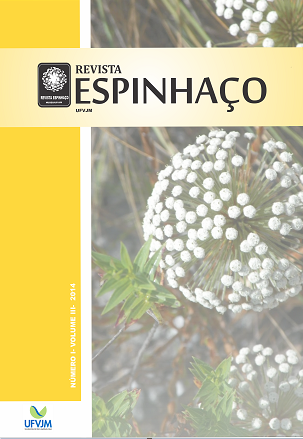Municipal clipping on Southeast and Southwest, Parana State: relationship between social and economic factors with deforestation in the Araucaria Forest?
DOI:
https://doi.org/10.5281/zenodo.3966227Keywords:
deforestation, araucaria forest, population dynamic, socioeconomic factorsAbstract
Is it possible to identify deforestation causes in Araucaria Forest based on social and economic factors? Are these factors equivalent in driving deforestation within areas with different deforestation rates? To answer these questions we evaluate two regions
within Parana State. The first region had almost no deforested area whereas the second one had around 15,000 ha of deforestation identified from 2000 to 2010. The factors were correlated with deforestation estimated on a municipality basis. After, we used the
Hierarchical Cluster Analysis to aggregate variables within similar clusters. For the first region (with almost no deforested areas), results showed no significant relationship between factors and observed deforestation. On the other hand, deforestation rates for the second region presented strong correlation with social and economic factors, following this order of relevance. More specifically, deforestation rates showed to be strongly correlated with agricultural activities and forest activities.
References
BALHANA, A.P.; MACHADO, B. P.; WESTPHALEN, C. M. História do Paraná. 2. ed. Curitiba: Gráfica Editora Paraná Cultural Ltda. 1º Vol. 1969.
BRASIL. Lei nº 11.428, de 22 de dezembro de 2006. Dispõe sobre a utilização e proteção da vegetação nativa do Bioma Mata Atlântica, e dá outras providências.
ELSTON, D. A.; BUCKLAND, S. T. Statistical modeling of regional GIS data. An overview. Ecological Modelling. v. 67, n.1, p. 81-102, 1993.
GEIST, H. J.; LAMBIN, E.F. What drives tropical deforestation? A meta-analysis of proximate and underlying causes of deforestation based on subnational case study evidence. Louvain-la-Neuve: LUCC Report Series. n. 4. 2001. 116p.
INSTITUTO BRASILEIRO DE GEOGRAFIA E ESTATÍSTICA (IBGE). Censo demográfico de 2000: Paraná. Rio de Janeiro: IBGE, 2013. Disponível em: <http://www.ibge.gov.br/censo/divulgacao_digital.sht m.> Acesso em julho de 2013.
INSTITUTO BRASILEIRO DE GEOGRAFIA E ESTATÍSTICA (IBGE). Censo agropecuário de 2006/2007: Paraná. Rio de Janeiro: IBGE, 2013. Disponível em: <http://www.ibge.gov.br/home/estatistica/economia/ag ropecuaria/censoagro/2006/>Acesso em julho de 2013.
INSTITUTO BRASILEIRO DE GEOGRAFIA E ESTATÍSTICA (IBGE). Censo demográfico de 2010: Paraná. Rio de Janeiro: IBGE, 2013. Disponível em: <http://censo2010.ibge.gov.br/.> Acesso em julho de 2013.
INSTITUTO PARANAENSE DE DESENVOLVIMENTO ECONÔMICO E SOCIAL (IPARDES). Leituras regionais: mesorregião geográfica do Sudoeste do Paraná. Curitiba, 2004a. 140p.
INSTITUTO PARANAENSE DE DESENVOLVIMENTO ECONÔMICO E SOCIAL (IPARDES). Leituras regionais: mesorregião geográfica do Sudeste do Paraná. Curitiba, 2004b. 134p.
INSTITUTO PARANAENSE DE DESENVOLVIMENTO ECONÔMICO E SOCIAL (IPARDES). Anuário estatístico do Estado do Paraná de 2011. Curitiba: IPARDES, 2013. Disponível em: <http://www.ipardes.pr.gov.br/anuario_2011/index.htm l.> Acesso em julho 2013.
JOHNSON, R. A.; WICHERN, DEAN. W. Applied Multivariate Statistical Analysis. New Jersey: Pearson 6. Ed. 773p., 2007.
MINISTÉRIO DO MEIO AMBIENTE (MMA). Proteção e recuperação da Floresta com Araucárias. Propostas de criação de novas Unidades de Conservação Federais no Paraná e em Santa Catarina. Brasília: Ministério do Meio Ambiente, Instituto Brasileiro do Meio Ambiente e dos Recursos Naturais Renováveis e Grupo de Trabalho Araucárias Sul, 2005. Disponível em: Acesso em agosto de 2013.
MONDARDO, M. L. A dinâmica migratória do Paraná: o caso da região do Sudoeste ao longo do século XX. Revista Brasileira de Estudos Populacionais. Rio de janeiro, v. 28, n. 1, p. 103-131, 2011.
NOSELLA, C.; ALCÂNTARA, S. A historia do café no Paraná. Londrina: Editora UEL, 2001.
NUNES, P. A.; MELO, C. O. Estrutura Produtiva da Mesorregião Sudeste Paranaense com Abordagem Insumo-Produto. Revista Paranaense de Desenvolvimento, Curitiba, n.123, p.179-212, 2012.
OLIVEIRA, L. A. P; OLIVEIRA, A. T. R. Reflexões sobre os deslocamentos populacionais no Brasil. IBGE: Estudos & Análises. Informação demográfica e socioeconômica. 2011. 103p.
PIRES, P. T. L. Alternativas políticas e jurídicas para a gestão das florestas de araucária no estado do Paraná. 199 f. Tese (Doutorado em Ciências Florestais). Universidade Federal do Paraná. Curitiba: UFPR, 2003.
SOS Mata Atlântica/INPE. Atlas dos remanescentes florestais da mata atlântica período 2008-2010. São Paulo: SOS Mata Atlântica, INPE. 2010. 122p.
SOS Mata Atlântica/INPE. Shapefiles dos remanescentes florestais 2000 e 2010. Disponível em: <http://mapas.sosma.org.br/dados/.>Acesso em julho de 2013.
Downloads
Published
How to Cite
Issue
Section
License
Copyright (c) 2022 Revista Espinhaço

This work is licensed under a Creative Commons Attribution-NonCommercial-NoDerivatives 4.0 International License.


